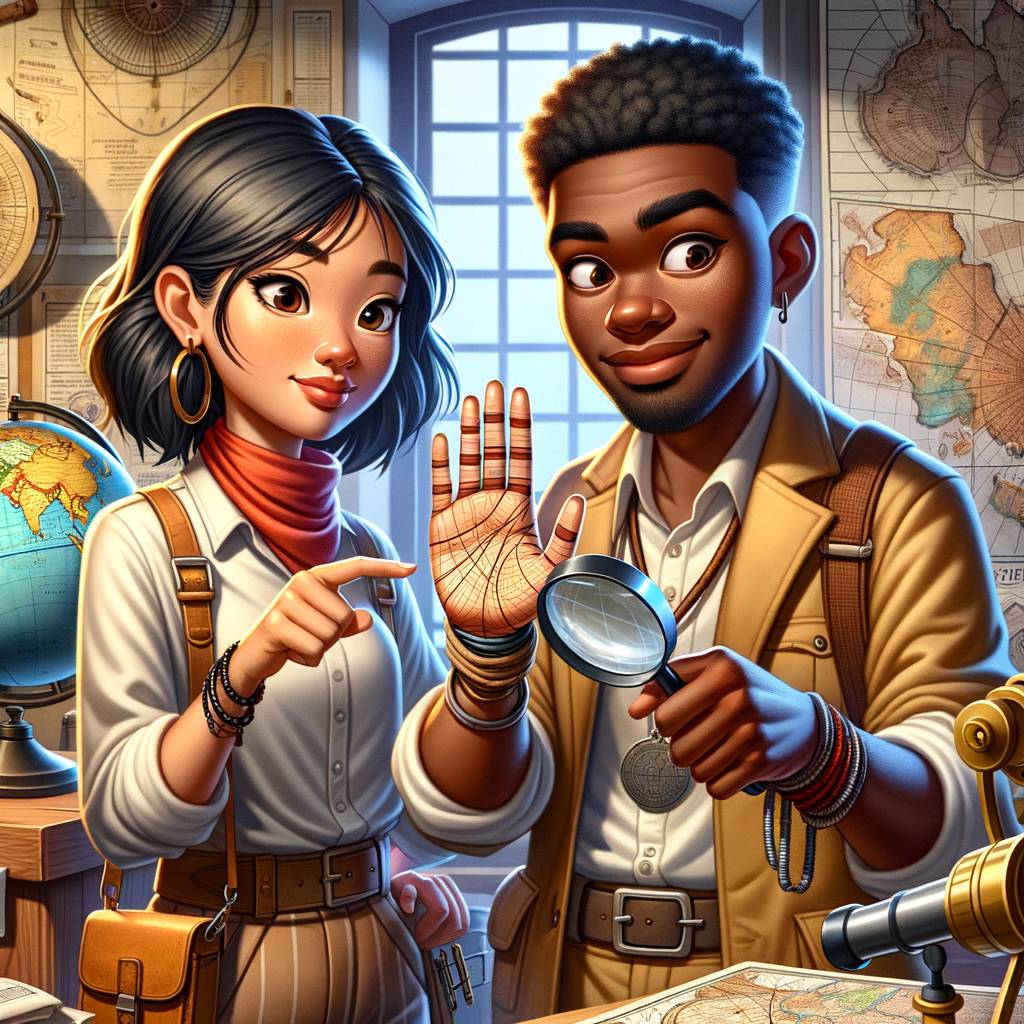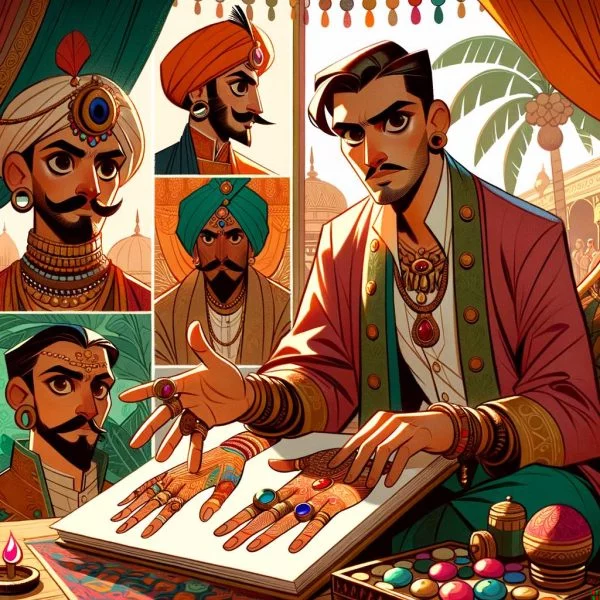Palmistry for Kids: Unlocking the Secrets in Little Hands
Ever wondered if your child’s hands hold secret clues to their personality traits and future potential? Look no further than the fascinating world of palmistry, also known as palm reading. Dating back centuries, this mystical art form isn’t just reserved for adults seeking cosmic revelations – it can also be an entertaining and educational activity for kids. By introducing palmistry to children, not only can you spark their curiosity and imagination, but you can also help them develop valuable skills such as observation, critical thinking, and empathy.
Empowering Entertainment: Where Fun Meets Learning!
Let’s face it: as parents and educators, finding fun yet educational activities that captivate young minds can be a challenge. But fear not, palmistry for kids brings the best of both worlds! It’s a delightful way to engage children while simultaneously nurturing their cognitive and emotional development. After all, who wouldn’t want their child to learn a thing or two while having a blast?
Unlocking the Secrets: What We’ll Explore in This Article
In this compelling read, we’ll dive deep into the realm of “Palmistry for Kids: A Fun Way to Introduce the Craft.” We’ll unravel the mysteries behind palmistry and how it can illuminate your child’s unique qualities and talents. Along the way, we’ll also share practical tips and techniques for parents and educators to make the palmistry experience enjoyable, interactive, and age-appropriate. From decoding the meaning of different hand shapes to deciphering the significance of various lines and mounts, get ready to uncover the secrets hidden within your little one’s hands!
Unraveling the Secrets of Palmistry
Have you ever wondered if your hands hold the answers to your future? Well, that’s where palmistry comes into play! This intriguing art dives deep into the lines, shapes, and other unique features of your palms to decode your character traits and unlock your potential destiny.
The Mirror of Your Soul: Dominant Hand Analysis
Did you know that each hand tells a different part of your story? When it comes to palmistry, your dominant hand takes center stage, shining a light on your present and future. It’s like a crystal-clear reflection of your current self, your aspirations, and the pathways that await you.
The Tapestry of Your Past: Non-dominant Hand Revelations
Your non-dominant hand is no less fascinating than its counterpart. In palmistry, this hand represents the echoes of your past experiences and the influence of your inherited traits. It’s as if your ancestors have left imprints on your palm, telling tales of their triumphs and tribulations.
The Magic of Palmistry: Why It’s Great for Kids
Unlocking the hidden secrets of the hand can bring a world of benefits to children. Let’s delve into how introducing palmistry to kids can have a positive impact on their overall development.
Enhancing Observation Skills
By venturing into the realm of palm reading, kids learn to sharpen their observation skills. As they closely examine the lines and shapes on their hands, they become masters of attention to detail. Just like detectives solving mysteries, they connect the dots and form interpretations, harnessing their powers of perception.
Igniting Critical Thinking and Problem-Solving
Palmistry isn’t just about lines and shapes—it’s a puzzle waiting to be solved! Engaging in this ancient art encourages children to think critically. They analyze the various components of the hand, like puzzle pieces, and piece them together to create a comprehensive interpretation. This process nurtures logical reasoning skills and expands their mental flexibility, preparing them for real-world problem-solving.
Cultivating Empathy and Understanding
Palmistry is a gateway to empathy and understanding for kids. As they explore the intricacies of palm reading, they gain insights into the unique characteristics and traits of individuals. They come to appreciate the diverse tapestry of human personalities, embracing the beauty of differences. By recognizing and celebrating individuality, palmistry nurtures a more compassionate and inclusive mindset in children.
Engaging Kids in Palmistry: Fun and Interactive Approaches
To introduce the enchanting world of palmistry to kids, it’s crucial to adopt an approach that blends education with entertainment. By incorporating these exciting activities, parents and educators can make the learning process enjoyable and interactive:
1. Storytelling: Unleash the Power of Imagination
Weave a captivating tale around palmistry, where characters’ destinies are magically intertwined with the lines on their hands. Encourage kids to embark on their own creative journeys by imagining unique stories based on the lines etched on their palms. Let their imagination run wild!
2. Art and Craft: Painting Hands, Unveiling Secrets
Turn palmistry into a hands-on experience – quite literally! Organize a vibrant palm painting activity where children can unlock the mysteries hidden in the intricate lines of their hands. This tactile exploration adds a visual element to palmistry, making it even more captivating for young learners.
3. Role-playing: Unveil the Hidden Genius
Unleash the little palm readers and fortune seekers within the kids! Encourage them to take on roles as both the palm reader and the person getting their hands read. This delightful role-playing exercise allows them to experience the process firsthand, boosting their understanding and enhancing their communication skills. Who knows, they might discover a hidden knack for divination!
4. Interactive Apps: Learning Made Engaging
Make use of technology to create an immersive learning environment. Incorporate educational apps and online resources that offer interactive palmistry experiences designed specifically for children. With these digital tools, kids can embark on a guided palmistry journey filled with excitement and discovery, making the learning process both engaging and informative.
Ethical Considerations and Limitations
So, you’ve learned about palmistry and are excited to share this fun activity with your kids. But before we dive into the palm reading extravaganza, let’s discuss some ethical considerations and be aware of the limitations of palmistry. While palmistry can be a fascinating activity for kids, it’s important to set boundaries and make sure everyone understands the purpose of this entertaining practice.
1. Palmistry for Entertainment Purposes Only
Palmistry should always be approached with a lighthearted and playful mindset. Remember, it’s all about having fun and exploring something new. Emphasize to your kids that palmistry should never be used to judge someone’s worth or predict their future success. Instead, encourage them to see it as an entertaining way to learn more about themselves and others.
2. Respect and Individual Characteristics
In the world of palmistry, every individual is unique, and their characteristics and personality traits are richly diverse. It’s crucial to maintain a positive and respectful attitude towards the people involved in this activity. Teach your kids that everyone’s hands tell a different story and that these stories should be appreciated and celebrated.
By focusing on the positive aspects of palmistry, you can nurture a sense of inclusivity and curiosity, making the experience enjoyable for everyone involved. Remember, it’s not about judging or labeling, but rather promoting understanding and appreciation.
3. The Limitations of Palmistry
While palmistry offers fascinating insights, it’s important to remind children that it is not a crystal ball that predicts their future with certainty. The lines on their hands are like a map of their potential and personality traits, influenced by their actions and choices. As they grow and change, these lines may also evolve.
Encourage your kids to see palmistry as a tool for self-reflection and self-discovery rather than a fortune-telling device. It can help them understand their strengths, weaknesses, and potentials, but it’s ultimately up to them how to shape their own destinies.
By setting realistic expectations, you provide a balanced perspective and allow your children to explore palmistry in a healthy and empowering way.
Engaging in Meaningful Conversations
After diving into the fascinating world of palmistry with children, it’s important to stimulate engaging discussions and reflections. These conversations not only help children process their experiences but also foster a deeper appreciation for the art of palmistry. So, get ready to spark some intriguing conversations and encourage children to share their thoughts and insights!
Reflecting on New Discoveries
Begin by asking thought-provoking questions to help children reflect on what they learned from the palmistry activity. These questions could include:
- What surprising or unexpected discoveries did you make about your palm?
- Did you notice any patterns or characteristics that made you curious?
- How did the interpretations of your palm make you feel?
Exploring the Accuracy of Palmistry
Next, delve into a lively discussion about the accuracy of palmistry. Encourage children to express their opinions and share their perspectives on whether they believe palmistry is an accurate way to know someone. Some questions that can fuel the conversation are:
- Do you think the lines on your palm can truly reveal secrets about your personality or future?
- What factors might influence the accuracy of palmistry?
- Are there any other personality assessment tools or methods that you find more reliable?
The goal here is not to debunk or prove the validity of palmistry, but to let children explore their own beliefs and reasoning.
Applying Palmistry Skills in Everyday Life
Finally, encourage children to consider how the skills they gained from palmistry can be applied in other areas of their lives. Help them connect the dots and discover the broader implications of their newfound knowledge. Some ideas to prompt their thinking include:
- How can understanding the importance of details in palmistry improve your attention to detail in schoolwork or other activities?
- What insights from palmistry can you apply to better understand and empathize with others?
- Can palmistry inspire you to explore other forms of divination or cultural practices?
By encouraging these discussions and reflections, we open doors to a wider exploration of palmistry and its potential impacts in various aspects of life.
A Journey of Wonder and Growth for Young Minds!
Introducing palmistry to kids is not just about unlocking the mysteries of the human hand, but also about fostering personal growth and understanding. Throughout this article, we’ve explored the myriad ways palmistry can engage and enlighten young minds. By engaging children in the practice, parents and educators can help develop their observation, critical thinking, and empathy skills.
Unlocking the Power of Storytelling and Creativity
Through storytelling, art and craft activities, role-playing, and interactive apps, children can embark on a journey where imagination meets learning. Palmistry becomes more than just lines on a hand; it becomes a world of possibilities where children can connect with their own inner wisdom.
While exploring this art form, it is essential to remember ethical considerations and emphasize its limitations. By encouraging discussions and reflections, children can grasp the complexities of palmistry, recognize the importance of individual choices, and understand the influence of environment and personal experiences.
Embrace the Magic, Share the Journey!
As we’ve discovered, introducing palmistry to kids can be a fascinating and transformative experience. So, why not share this knowledge with others? Spread the excitement and possibilities by sharing this article on Facebook, Twitter, and LinkedIn. Let’s create a community of curious minds who help each other grow and explore.
Remember, palmistry for kids is not about fortune-telling or predicting the future. It’s about encouraging children to embrace their uniqueness, understand themselves and others better, and unlock their potential for empathy and self-discovery. It’s a tool that can offer valuable insights and guidance as young minds navigate the complexities of life.
Just like the lines on our palms, our journey through life is filled with twists and turns, surprises and challenges. By introducing palmistry to kids, we equip them with a sense of wonder and curiosity that will guide them on this wondrous path, helping them embrace their true selves and thrive in a world of endless possibilities.






